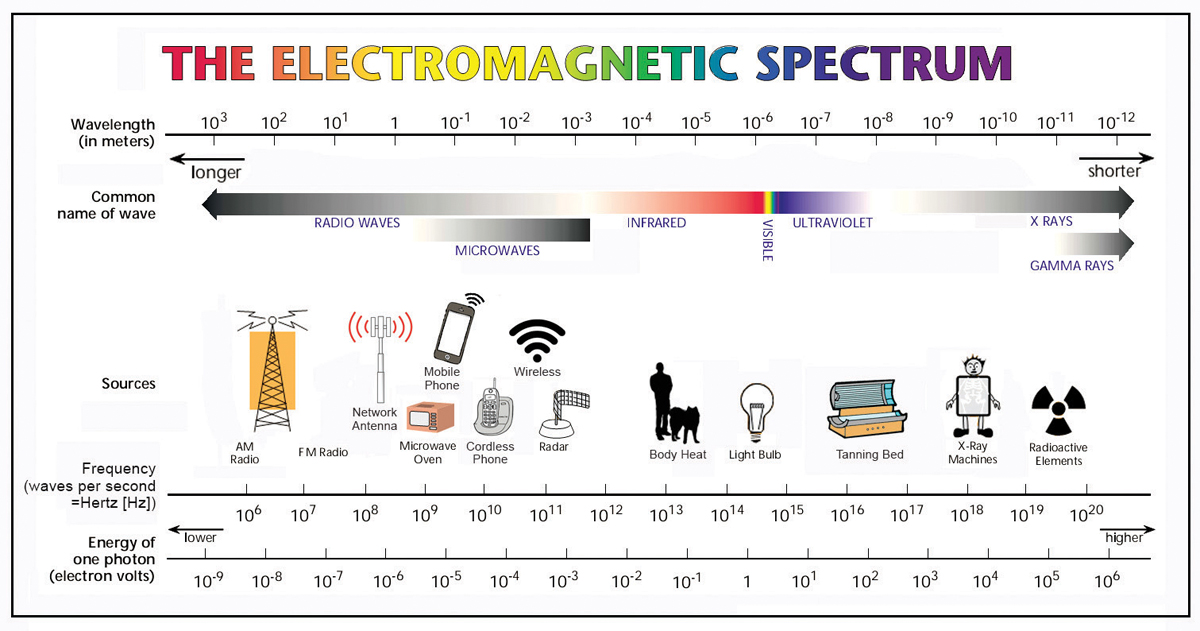By Meg Sears
Beyond the rainbow is an invisible spectrum of waves. Innumerable inventions in today’s electrified world are exposing the entire biosphere to an increasing glare of novel “light.”
Most spectacular is radiofrequency radiation or RFR–the eletromagnetic signals used in wireless communication. This range of radiofrequency is poised to fuel the fifth generation or 5G broadband. Coming soon, we will have an Orwellian vision of what is now termed the Internet of Things, transmitting data via wireless signals from and to tens or hundreds of billions of devices. Information about everything from social media, email and phone calls, shopping, banking, building controls and security, to the state of your baby’s diaper or supplies in your refrigerator will all be at your fingertips. If done wirelessly, this could swamp our world in an unprecedented intensity of RFR.
All life on this planet evolved with certain electromagnetic radiation (EMR), such as visible light, but the Earth’s atmosphere provides natural protection from cosmic-sourced radiation. The 20th Century brought electrification and lower frequency EMR. By mid-century higher frequencies were introduced and used in radar, military and emergency response radio communications, and radio and television broadcasting. These signals have wavelengths long enough to travel through the earth and buildings.
Communication rapidly advanced from dots and dashes, to radio with music and news. Then during the 1960s, black and white television advanced to colour TV. Broadcasts were transmitted using radiofrequency radiation in the lower frequency bands, that traversed great distances. Everyone listened or watched programs at the same time.
Early wireless communication connected ham radio operators, drivers in vehicles via citizen band, and the 1970s brought the first cellular phone. The size of a brick, it cost thousands of dollars and had battery power for a half-hour conversation.
Fast forward: today’s devices are smaller, lighter and faster, with longer-lasting batteries and many capabilities. Successive generations brought about the smart phone with its texting, Wi-Fi, Internet, live streaming, and full business integration. The fifth generation, 5G, is marketed to reach into all details of our lives, connecting everything with the “Internet of Things.”
Within this current generation, humans have increased their use of radiofrequency radiation exponentially. We no longer gather around the television set at a designated time. Instead, we stream on demand. From 2016 to 2017, the number of mobile phones in Canada increased 3%, mobile data increased 30% but television viewing diminished substantially. A program that was previously broadcast a few times is now being transmitted thousands or millions of times, to single-user screens. A substantial portion of that transmission is broadcast wirelessly.

To keep up with this demand for more data and higher speeds, 3G and 4G wireless are being used more intensively and 5G will expand to higher frequencies with millimeter scale wavelengths. Along with tens of thousands of satellites hovering above the earth and large antennae on towers, small cell intensive antennae are being densely deployed along streets in certain cities, closer to users.
This ever-increasing electronic noise is biologically harmful and degrades the quality of transmissions along telephone wires. The RFR also disrupts the finely-tuned biochemistry of life, damages cells, causes dysfunction and cancer, impairs development and can lead to chronic ill health with ongoing exposure. Some people develop electromagnetic hypersensitivity.
Radiofrequency radiation impacts all life forms. Most obviously, trees close to cell towers suffer damage on the side closest to the tower, then die prematurely. When the wavelength matches the size of small creatures such as insects, as will happen with millimetre waves, the likely result will be substantial damage and death.
Magnetite, found in microbes, insects, mollusks, fish, birds and mammals, is a mineral that allows organisms to detect magnetic fields. Birds and insects, with magnetite above their beaks and in their abdomens, get lost when exposed to radiofrequency radiation. Birds get disoriented in cities, and bees don’t return to hives. We don’t know the role of magnetite in human brains, but this mineral may be partially implicated in damage associated with RFR emitted by cell phones.
In 2011, the World Health Organization’s International Agency for Research on Cancer or IARC, convened a panel of experts who concluded that RFR possibly causes cancer in humans (Group 2B). Since then, the particular types of tumours associated with cell phones are increasing in young adults, and cases are reported of breast cancer where cell phones were carried in bras. Further analysis of human data and three new, large animal studies, lead experts to conclude that RFR definitely causes cancer. If a similar expert panel were convened today, it would most probably conclude that RFR is a known human carcinogen (Group 1, which includes tobacco smoke and asbestos). RFR is a high priority for re-evaluation in the IARC 2020-2024 workplan.
Cancer is the long-term culmination of cellular damage, inflammation and the breakdown of protective mechanisms in the body. Other contributors include adverse chemical exposures, poor diet and stressors, but the fact that radiofrequency radiation is biologically active and causes harm is now beyond debate.
It may be hard to disentangle effects of radiofrequency radiation from those of screen time and lifestyle in people, yet animal studies demonstrate damage in the brain and organs, and impairment (e.g., memory and balance) in animals exposed to RFR early in life.
If a human foetus is exposed to higher levels of RFR, the child is more likely to exhibit poor behaviour and learning.
The Canadian Paediatric Society (CPS) recommends limited the use of wireless devices to address the effects of screen time on social interactions. Children fare better with undistracted attention from parents and other caregivers when they do not have to compete with electronics. Unlike measures in some European, American and other jurisdictions (e.g., Cyprus) to limit children’s exposure, the CPS does not yet mention harmful effects of RFR, nor advise minimizing exposure.
Schools that were early adopters of the Internet installed cable and wired connections, but those have largely been abandoned in favour of Wi-Fi. Following the introduction of Wi-Fi, some students and teachers began experiencing excruciating headaches, cardiac arrhythmia and other adverse effects. There is no evidence that educational outcomes improved with wireless connectivity.
Radiofrequency radiation impairs male fertility, as sperm quantity and vitality are reduced when cell phones are in pockets and laptops on laps. Some fertility clinics query the use of wireless devices.
The Electromagnetic Spectrum
Beyond the fringes of the colours of visible light, at lower frequency we feel the heat of infrared radiation. Beyond vibrant red through yellow and blue to violet, are higher frequency ultraviolet, then x-rays and gamma rays.
 Light–indeed, all electromagnetic radiation (EMR)–behaves both as a wave and as a particle, called the “wave-particle duality.” Electromagnetic radiation travels like a wave at the speed of light, so higher frequencies have shorter wavelengths. Light–indeed, all electromagnetic radiation (EMR)–behaves both as a wave and as a particle, called the “wave-particle duality.” Electromagnetic radiation travels like a wave at the speed of light, so higher frequencies have shorter wavelengths.
Electromagnetic radiation also behaves as particles called photons. A single photon of high-frequency ionizing radiation, such as X-rays and gamma rays, can remove an electron from an atom, creating a charged atom called an ion. The first recognized hazard of radiation, such as X-rays, was burns, but even low doses of ionizing radiation harms cells, and DNA damage leads eventually to cancer.
(continued on next page)
This powerful radiation is now carefully engineered for medical and scientific applications.
At the far end of the scale, the extremely low frequency Schumann Resonances, starting at 8 cycles per second or Hertz (Hz) and higher, have a wavelength approximately the circumference of the Earth or a fraction (half, third, etc.). See diagram above. This is resonance of EMF pulses from lightning channelled beneath the ionosphere high in the atmosphere.
Tips to reduce your exposure to radiofrequency radiation
• Wireless transmissions should not be the standard. Fibre-optic cable is more secure, reliable and resilient, requires less energy to transmit signals and results in no RFR. Demand and install wired infrastructure whenever and wherever possible.
• Distance is your friend with wireless devices. Keep phones, tablets, etc. away from your head and body, and off your lap.
• Use text messaging instead of voice calls whenever possible.
• Make only short or essential calls on cell phones, using speaker phone or an air tube headset.
• Power off phones and personal digital devices, or set on airplaine mode. Turn off Wi-Fi, Bluetooth, Mobile Data, Mobile Hotspot and Location.
• Avoid charging phones and devices near beds.
• Use corded (not cordless) home phones, wired (not wireless) whenever possible, especially for lengthy conversations.
• Pre-download videos and music rather than streaming.
• Minimize the number of apps running on wireless devices.
• Choose wired Internet connections over wireless systems.
• If Wi-Fi cannot be eliminated, put the Wi-Fi router on a timer to turn off when not needed (especially while sleeping).
For additional articles on radiocommunication, go to
www.PreventCancerNow.ca and www.earthhavenlearning.ca
|


![]()


 Light–indeed, all electromagnetic radiation (EMR)–behaves both as a wave and as a particle, called the “wave-particle duality.” Electromagnetic radiation travels like a wave at the speed of light, so higher frequencies have shorter wavelengths.
Light–indeed, all electromagnetic radiation (EMR)–behaves both as a wave and as a particle, called the “wave-particle duality.” Electromagnetic radiation travels like a wave at the speed of light, so higher frequencies have shorter wavelengths.